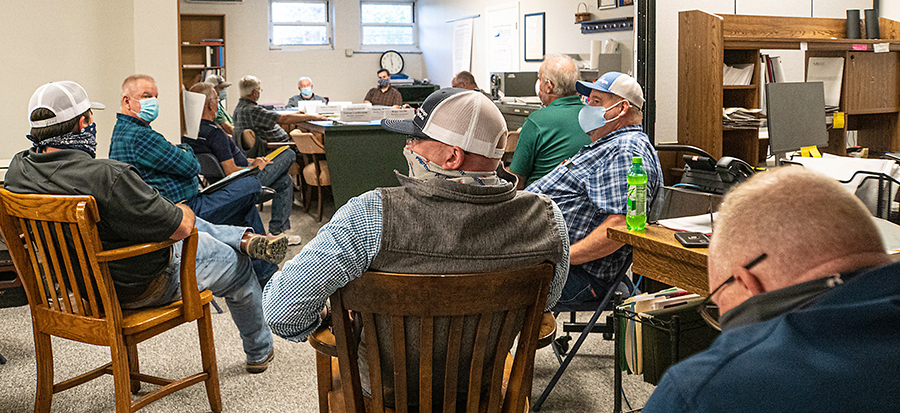By Lon Anderson
Moorefield Examiner
At its October meeting, the Hardy County Planning Commission’s probing for the best way to regulate future agricultural “mega projects” proceeded full steam ahead.
The Commission is under instruction from the County Commission to take steps to ensure that any proposed future developments like the $10 million, 20-poultry house “mega-project” now under construction near Old Fields will require hearings and notification to local residents prior to construction. The current county zoning ordinance does not require any notifications or hearings.
The October 6 meeting was held indoors for the first time since last spring, and about a dozen folks—poultry growers, Pilgrims’ staff, and residents from Old Fields were on hand to monitor and participate.
Different this month was the attendance of Pilgrim’s land use attorney, Mark Sadd from Charleston, with the firm Lewis Glasser Casey and Rollins. Sadd told the Commission that his goal was “to try to help shape discussions and to get a good and balanced ordinance that’s good for all.” He also suggested that the Commission consider engaging its own attorney in the discussions.[private]
Commission President Lee Lehman responded, “I just feel that we are still a long ways off from that point” of needing an attorney and noted that the Commission does not yet even know the right questions to ask. “We expect to have counsel, but we are so early, we’re not ready,” he said.
“I do agree with Lee – at this time we don’t have the questions focused yet,” said Commission Vice President Greg Greenwalt.
Lehman suggested that a good starting place for the evening’s meeting would be answering the question: at what point would you trigger the hearing process and what would the criteria be to do that? The Commission wants to let smaller or more “normal size” applications for construction of poultry houses go forward with minimal administrative requirements as happens now.
“Is there a point where it’s business as usual?” Lehman asked, and is that “determined by the number of animals, the number of houses, the number of acres or something else? Is there a point where there are too many and it should be treated differently?”
“What do you feel?” Lehman asked Sadd. “Is there a point where you have to do more (scrutiny/regulation)?”
“It just depends,” Sadd responded. “Agriculture is very protected in West Virginia.”
The Commission is currently working from a draft zoning ordinance proposed by its consultants, Berkeley Group. That draft provided a framework but left specific measures blank for the Commission to decide.
“Berkley is a very fine company, but I don’t like their work here,” Sadd said. “I don’t think they took West Virginia law into account,” suggesting that the model they were working from might well result in an illegal solution.
“State law,” he asserted, “forbids you from preventing a farmer expanding operations (on his property). So, you might give incentives to encourage expansion in certain areas.”
“Maybe the focus (for a trigger) should be based on density,” Sadd continued. “I get the residential concerns—they’re important, but 60% of the County is zoned Agricultural and the current (land use) plan favors agriculture in Ag zones. Do you want to favor residential?”
Lloyd Foltz, Jr., a resident of Old Fields interjected: “but we’re the ones suffering a loss (in property values) and no one’s looking to cover us.”
“Do we know there’s a drop in real estate values?’ asked Nicole Rohrbaugh, Planning Office Administrative Assistant.
“Not at this point,” responded local Grower Ronnie Miller. “It’s (the mega-project) not open yet so it’s not an issue.”
“I agree with you that residential values are at risk,” Sadd said, “but you’re going to tell a grower that he can’t expand to keep his farm profitable? You can’t stop them from adding houses. The law says you can’t stop a farmer from expanding its use.”
“I think we need to look at our neighbor, Rockingham County, I think they did say five acres per house,” Miller suggested.
And what happens when you are drawing so much water from wells? Miller asked. “What happens when you sink your neighbor’s well? You might want to have some money put in escrow to deal with that.”
Michael Sullivan from Pilgrims noted that they estimate that you need about 5 acres per (poultry) house.
“There’s a lot to consider,” noted Old Fields resident Steve Pendleton. “Poultry has done a lot for the County, but there has to be a balance (with residential).”
“Beware of unintended consequences,” Sadd warned, noting that driving up costs for farmers through regulation “can drive out the small farmers, push them right out.”
“We have several 12-house properties,” said Pilgrims’ Tim Cullers, “but it has never been our intent to build mega farms. We would rather rely on small farms, but we have to get this (Moorefield) plant to full production.”
“You’re going to have to do what you have to do,” noted Pendleton.
“So if a permit request came in now for 20 houses, what would happen?” asked Miller.
“We’d have to approve it,” Lehman said. “There’s nothing on the books (to stop it).”
“Should the Commission focus on a time frame for its work or consider a temporary ordinance to deal with any applications that may come in (in the interim)?” Pendleton asked.
“I just say let’s get on with it (work on the new ordinance),” responded Sadd, the Pilgrims’ attorney.
“There are a lot of older, unused houses sitting around that could be updated,” Miller suggested as an alternative to building new poultry houses. “I would like Pilgrims to look at incentives to rehab old houses and get them back on line.”
“I’d like to see as much effort put into getting older houses back in business as the effort to build new ones,” said Commissioner and local poultry farmer Tim Wilkins.
Sullivan responded that Pilgrims does have some incentives in place to improve older houses in operation.
Discussion also included concern over the dwindling amount of land available for putting more poultry houses in the county. There’s only about 15 square miles still available in Hardy, Pendleton noted.
“There are places, industrial sites that are not in the middle of residential areas,” Foltz said. “Growers need to join with us (on this ordinance) or some are going to get pushed out.”
Daryl See, President of the West Virginia Poultry Association, noted that the Delmarva area, once known for its poultry operations is no longer adding poultry farms because of all the residential growth moving in.
Ben Martin, the Commission’s Planning Assistant attempted to return to the original question on the floor: “Is there a certain point where the number of (poultry) houses might be of concern? Is there a number than can be agreed upon? We want them to be profitable, but fair to everybody involved.”
“I would challenge the homeowners to suggest some numbers,” Rohrbaugh said. “What would be acceptable to you? Give us some concrete numbers such as setbacks that would be acceptable to you.”
“One of the things that’s particularly important to us (in considering setbacks) is the wind which blows hard from the west, especially in the winter,” Pendleton noted. “Another is the water and I know wells have been dug, but I don’t know how they are going to affect us. Where are we at with use of public water for that site?”
“We haven’t ruled it out,” responded Robert Williams, who is the developer of the mega project as well as a Planning Commissioner.
Jeff Courtney, the senior Pilgrims representative volunteered that “We will be willing to put together a generalized proposal for you by the next meeting.”
Sadd again noted that the Commission should be working with an attorney on this and noted that he had worked closely with Jesse Richardson, the lead land use attorney at the WVU Land Use and Sustainable Development Law Clinic and would be happy to discuss this with him. The Planning Commission has frequently used that clinic’s legal services in the past.
“So you’re saying you will get hold of Jesse and get him involved?” Lee asked
“I will talk to Jesse,” Sadd replied.
In other business, the Commission agreed to move its next meeting to the second Tuesday, Nov. 10, since the first Tuesday will be Election Day.
Rohrbaugh reported that the Planning Office had issued 25 building permits in September, worth an estimated $1,180,000.[/private]

